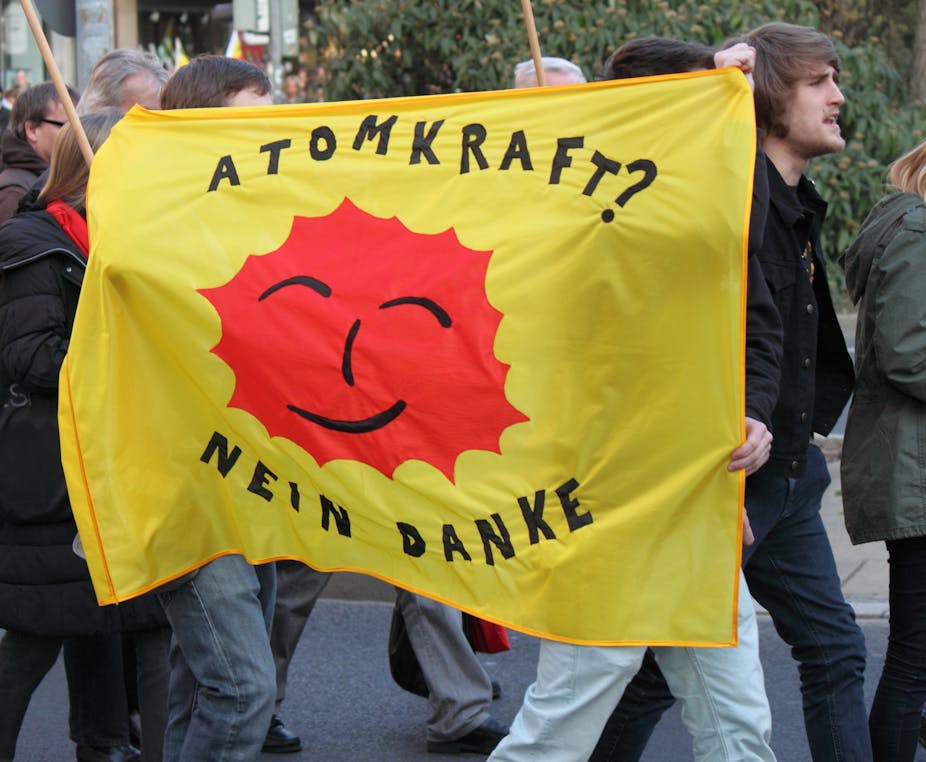When the Fukushima Daiichi nuclear power plant in Japan was hit by a tsunami in March 2011, the disaster had a profound effect on German energy policy. Chancellor Angela Merkel reasoned that “Fukushima has forever changed the way we define risk in Germany.”
Three days after the news of meltdown in three of Fukushima’s reactors, Chancellor Merkel drew a line under German nuclear power. The seven oldest nuclear power plants in Germany were immediately taken off the grid, and two months later the government made this permanent. The remaining German nuclear power plants, it was decided, would be shut down by 2022.
This decision was a spectacular policy U-turn, as the same conservative government had only recently overturned an earlier attempt to ban nuclear power in Germany. In 2010, Chancellor Merkel’s coalition had argued that nuclear power was a “bridge technology” necessary to pave the way towards a carbon-free energy system. The prolonged use of nuclear power would be indispensable in order to guarantee security of supply, it was claimed.
This raises two questions: did removing seven power plants endanger the security of supply to the German national grid? And what convincing long-term strategy is there in place to manage the shift to carbon-free energy without nuclear power?
The loss of the power stations cut the nuclear contribution to the country’s energy by about a quarter, from 22% in 2010 to 16% in 2012. Yet Germany is still a net exporter of electricity, and the power not generated due to the shutdown has not led to a requirement to import foreign nuclear power. The key findings of a detailed study by the Institute for Applied Ecology on this matter clearly demonstrated this, where the authors stated that: “The existence of power imports is not an indication that the (domestic) security of supply is in jeopardy. The shutdown of nuclear power plants has not resulted in increased imports of power from foreign nuclear power plants and thus has not been counterbalanced by foreign power imports.”
In other words, the sudden shutdown of seven nuclear power plants had no detrimental effect on security of supply, and was compensated for within the German energy infrastructure.
Which policies and strategies does the Energiewende (the project to transform Germany’s energy system into a mainly renewables-based one by 2050) rely on? The Renewable Resources Act, passed in 2000, established a system of feed-in tariffs to promote the build-up of renewables. Renewables share in overall German electricity generation has since increased from 7% in 2000 to 23% in 2012. Each year, another 10,000 MW of (intermittent) renewables capacities are being installed - an amount that almost matches the remaining 12,000 MW of (non-intermittent) nuclear capacities from Germany’s nuclear reactors still in operation.
In fact, the policy of phasing out nuclear power begun in 2001, emerging from a long history of protests by the anti-nuclear mass movement that dates as far back as the 1970s. So depending on your view, Germany is really just back on track after the reminder of Fukushima.
The idea that it is irrational German angst that has led Germany to forge a path distinct from its neighbours doesn’t stand up to scrutiny: of 27 European Union member states, 11 have no civil nuclear power, and most have no intention of developing any. Four other European countries are joining Germany in phasing out nuclear power, while Italy closed its last nuclear power station in the 1980s, and in 2011 rejected plans to look at the issue again.
So Germany turning away from nuclear power is not a panicky reaction that endangers the country’s security of supply, more an important and well-integrated part of her transformation to use renewables exclusively.
Which is not to say that the Energiewende is without problems. Rising electricity bills and the costs of expanding many thousands of miles of transmission lines threaten to strain public acceptance. Rampant nimbyism and ecological and economic trade-offs have to be addressed; any plan for large offshore-wind farms that promise to provide efficient, renewable energy inevitably leads to conflicts with environmentalists.
Maintaining the power grid’s stability in a renewable-based system remains a challenge. But there is nothing to suggest that turning off nuclear power will jeopardise Germany’s clean energy vision. And where Germany leads, others may follow.
Part of our Nuclear Future series:
Tough decisions needed to keep Britain’s lights on
Renewables blossom in Germany’s post-nuclear vision
Thorium could be the silver bullet to solve our energy crisis
How 20th century atomic science played on our hopes and fears

